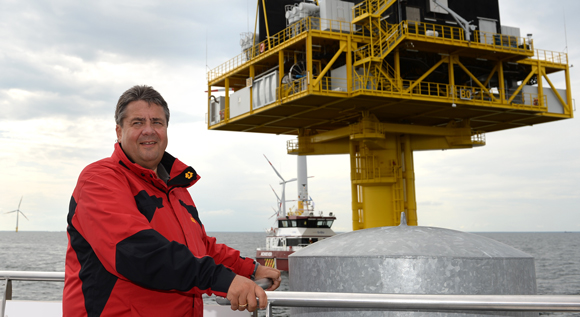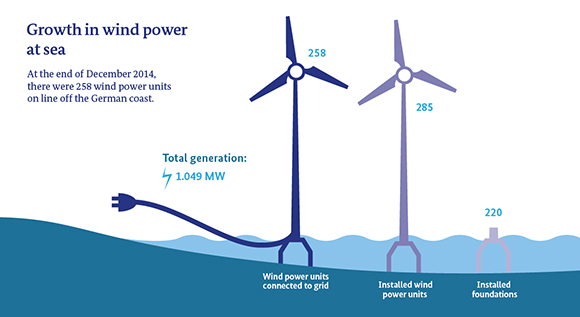Offshore blowing strong
Wind energy plays a cardinal role in the German renewable-energy mix. From the niche product of the 1990s it has evolved into a flagship of German mechanical engineering. Off our coasts more and more wind power units are feeding electricity into the grid.
 Sigmar Gabriel, Federal Minister for Economic Affairs and Energy © dpa
Sigmar Gabriel, Federal Minister for Economic Affairs and Energy © dpa
With a share of more than a third of electricity stemming from renewable sources, wind energy plays a cardinal role in the renewable-energy mix in Germany. Further to more and more new units on suitable onshore locations and the replacement of older, smaller units by modern, more powerful installations – this is called "repowering" – offshore wind power is also being expanded step by step. Most of the offshore projects in planning and under construction are located on the high seas off the German North Sea and Baltic coasts. Here experience is currently being gathered with projects in deep waters and at distances from the coastline that have never before been implemented in this form in Europe or anywhere else in the world.
Because wind speeds offshore are more constant and higher than on land, offshore units can generate much more output. By the end of December 2014, 258 wind power units in the German North Sea and Baltic Sea with a rated output totalling about one gigawatt were connected to the grid. The environmentally friendly electricity generated there is enough to supply more than a million households. In late November 2014, for example, the North Sea windfarm Meerwind Süd/Ost, situated to the north of the island of Heligoland, went on line with 80 wind power units – each with a rated output of 3.6 megawatts.
 © Chart: BMWi; Data: BWE/ VDMA Power system
© Chart: BMWi; Data: BWE/ VDMA Power system
Concrete expansion targets for more reliable planning
A prime target of the amended Renewable Energy Sources Act (EEG) that came into effect on 1 August 2014 is to steer the expansion of the renewables more intelligently. In view of the comparatively long lead times and high investments required for offshore windfarms, operators and investors need dependable terms of reference for their planning. Those intending to construct new installations can now choose between two assisted funding models: if they opt for what is called the accelerated model they get a higher price (19 cents per kilowatt-hour) for the electricity they feed into the grid for a shorter period of eight years. This makes for faster refinancing and reduces the investment risk. The EEG reform guarantees the availability of this instrument until the end of 2019. Under the alternative baseline model, by contrast, the guaranteed price is lower, at 15 cents per kilowatt-hour, but is paid for a longer term of 12 years.
At the same time, steering the amount of offshore wind power generated provides security for investment: the expansion target of 6,500 megawatts of installed capacity by 2020 ensures that the projects already in planning can be implemented as intended. Under the terms of the new ceiling on expansion, fixed at 15,000 megawatts by 2030, on average two new offshore windfarms per year can be installed as of 2020.
Federal Network Agency assigns line and connection capacities
Being able to connect the offshore windfarms to the grid on schedule is a major factor in creating certainty for long-term planning of projects and investment. Since 2013, the ongoing upgrading of the offshore grid connections has been based on an offshore grid development plan (O-NEP) to be drawn up by the German transmission grid operators and submitted to the Federal Network Agency (BNA) every year. This plan identifies the need for transmission capacities and co-ordinates the expansion of grid capacities at sea and on land. Following the amendments to the Energy Industry Act (EnWG) which came into effect on 1 August 2014, the German regulatory authority, the Federal Network Agency, is also responsible for assigning free power line and connection capacities in the North Sea and the Baltic to offshore windfarms. To this end it has published preliminary rules for an objective, transparent and non-discriminatory assignment procedure. Specifically, it has defined the prerequisites an applicant has to fulfil to be allowed to request these connection capacities and the procedure for auctioning the available connections if too many applications are received. By the end of February 2015, capacities totalling about 7,500 MW had been assigned to windfarms.

